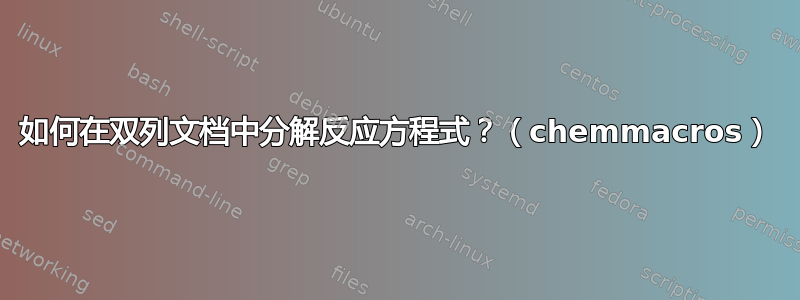
我必须以类似纸质的风格撰写实验报告,我们被迫使用双栏样式。
我环顾四周,发现 multicols 包在这方面做得很好,因为[twocolumns]文档类的本机选项存在一些问题。
我想使用reaction提供的环境,chemmacros因为我有自定义的反应标签,这样更容易自动为方程式和反应设置单独的标签。另一个好处是,我可以\listofreactions为我的文档创建一个。
这就是为什么我不想使用align或equation环境本身。
但是我会做出反应要么断线(手动或自动)要么适应列宽。
我努力了:
\begin{reaction}
\begin{split}
Si(OEt)4\, (l) + 4 H2O\, (l) ->[ "cat.\," NaOH ]\\
Si(OH)4\, (aq) + 4 EtOH\, (l)
\end{split}
\end{reaction}
and for solution 2 (aluminium in NaOH, named: aluminate solution)
\begin{reaction}
NaOH\,(aq) + Al\, (s) + 3 H2O\, (l) -> Na[Al(OH)4]\, (aq) + 3/2
H2\, (g) "."
\end{reaction}
Therefore we get
\begin{reaction}
12 Al(OH)3\, (aq) + 12 Si(OH)4\, (aq) + 12 NaOH\, (aq) ->
Na12((AlO2)12(SiO2)12)\, (aq) + 48 H2O\, (l) "."
\end{reaction}
答案1
在这种情况下,有一个amsmath方程环境。允许您通过执行以下操作来调整此环境以适应反应:multlinechemmacros
\NewChemReaction{multreaction}{multline}
这为您提供了更自然的输入,不需要\hspace{...}s或\notag:
\documentclass{article}
\usepackage[margin=3cm]{geometry}
\usepackage{chemmacros}
% \chemsetup{modules=reactions} % not needed any more in an up to date macros
\NewChemReaction{multreaction}{multline}
\usepackage{multicol,lipsum}
\begin{document}
\begin{multicols}{2}
\lipsum[1]
\begin{multreaction}
Si(OEt)4\lqd{} + 4 H2O\lqd{} ->[ "cat.~" NaOH ]\\
Si(OH)4\aq{} + 4 EtOH\lqd
\end{multreaction}
and for solution 2 (aluminium in NaOH, named: aluminate solution)
\begin{multreaction}
NaOH\aq{} + Al\lqd{} + 3 H2O\lqd{} -> \\
Na[Al(OH)4]\aq{} + 3/2 H2\gas{} "."
\end{multreaction}
Therefore we get
\begin{multreaction}
12 Al(OH)3\aq{} + 12 Si(OH)4\aq{} + \\
12 NaOH\aq{} -> \\
Na12((AlO2)12(SiO2)12)\aq{} + 48 H2O\lqd{} "."
\end{multreaction}
\lipsum[2-4]
\end{multicols}
\end{document}
在上面的例子中,我还添加了\lqd、\aq和\gas作为阶段标识符。
答案2
几乎不需要手动调整的解决方案
\documentclass{article}
\usepackage{chemmacros}
\chemsetup{modules=reactions}
\begin{document}
\begin{reactions}
Si(OEt)4\, (l) + 4 H2O\, (l) "\hspace{5cm}" \notag \\
->[ "cat.\," NaOH ] Si(OH)4\, (aq) + 4 EtOH\, (l)
\end{reactions}
and for solution 2 (aluminium in NaOH, named: aluminate solution)
\begin{reaction}
NaOH\,(aq) + Al\, (s) + 3 H2O\, (l) -> Na[Al(OH)4]\, (aq) + 3/2
H2\, (g) "."
\end{reaction}
Therefore we get
\begin{reactions}
12 Al(OH)3\, (aq) + 12 Si(OH)4\, (aq) + 12 NaOH\, (aq) "\hspace{2cm}" \notag \\
-> Na12((AlO2)12(SiO2)12)\, (aq) + 48 H2O\, (l) "."
\end{reactions}
\end{document}
四行字的反应
\documentclass{article}
\usepackage[margin=3cm]{geometry}
\usepackage{chemmacros}
\chemsetup{modules=reactions}
\usepackage{multicol}
\begin{document}
\begin{multicols}{2}
Therefore we get
\begin{reactions}
12 Al(OH)3\, (aq) + 12 Si(OH)4\, (aq) "\hspace{1cm}" \notag \\
+ 12 NaOH\, (aq) -> "\hspace{2cm}" \notag \\
Na12((AlO2)12(SiO2)12)\, (aq) "\hspace{0.5cm}" \notag \\
+ 48 H2O\, (l) "."
\end{reactions}
and for solution 2 (aluminium in NaOH, named: aluminate solution)
\clearpage
\end{multicols}
\end{document}






